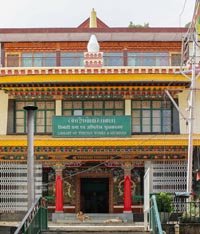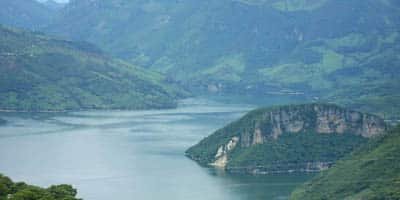Listen to the companion podcast here
Sixty-five years after the People’s Republic of China invaded Tibet, the diaspora is now shifting to the West. What are the advantages and disadvantages to a changing diaspora and why is it happening?
To find out, I spoke to three experts: Dr Namygal Choedup, the Representative of His Holiness the Dalai Lama at the Office of Tibet in Washington, DC, Dr Joanna Coelho, an associate professor at the DD Kosambi School of Social Sciences and Behavioural Studies at Goa University, and Dibyesh Anand, a professor in politics and international relations with a focus on China and Tibet at the University of Westminster.
Tibetan settlements across South Asia

Ten years following the 1949 invasion of Tibet, the Chinese government’s brutal crackdown on a Tibetan uprising forced many people to flee to Dharamsala, India and establish a government in exile, now referred to as the Central Tibetan Administration (CTA). An estimated 80,000 Tibetan citizens joined the Dalai Lama there in the early stages of exile, laying the foundations for a vibrant community that is the heart of the Tibetan diaspora. The CTA underwent a rapid process of democratic institution-building throughout the 1960s and continues to provide support and governance for Tibetan people in India. With the Dalai Lama as its figurehead, it advocates for Tibetan autonomy from its place of exile.
Early CTA initiatives put a strong emphasis on cultural, linguistic, and religious preservation as well as education through monastic institutions and the Tibetan Children’s Village. A steady influx of Tibetans into the refugee settlements throughout the 1960s bolstered the development of the Tibetan community. Reform and democratization featured prominently in His Holiness’ governing body. In a sense, the balance of modern secular institutions and educational avenues, alongside the preservation of traditional inner values, played a powerful role in determining the early success of these communities in India.

However, large numbers of people living in these communities have been choosing to leave for the West. The number of Tibetans in traditional communities, mainly in India but also some in Nepal and Bhutan, peaked at around 150,000 in the 1990s; since then, there has been a steady decline to just above 100,000 today, with much of that decline since 2014, according to stats provided by the CTA to the Migration Policy Institute.
Many Western countries opened their borders to Tibetan refugees beginning in the 1970s. Canada, for example, established a refugee resettlement program in 1972 that relocated 230 Tibetans from northern India. A similar program was rejuvenated in the mid-2010s. The US Immigration Act of 1990 also played a role in the slow but steady wave of immigration to the West. By 2020, an estimated half of the overall Tibetan population lived outside of South Asia: 25,098 in North America and 26,379 in Europe, Oceania, and East Asia.
Citizenship and language barriers for Tibetans in India

India constitutes the largest settlement of Tibetans outside of Tibet. Dibyesh Anand, a professor in politics and international relations with a focus on China and Tibet at the University of Westminster, explained that a key challenge for Tibetans living in India is the restriction on citizenship. Only Tibetans born in India, or who moved there, prior to 1989 are eligible for Indian citizenship. This leaves out the newer generation of Tibetans who were not born in India prior to 1989. “The young generation that’s not born in India, but born in Tibet, are what would be called the new refugees,” Anand said. “They’re the ones moving away very quickly because they have no status in India.”
Even those who are eligible for Indian citizenship often do not choose to apply. The CTA does not encourage Tibetans to take up Indian citizenship, viewing it as a threat to the national identity of Tibetans.
Another barrier is competition in the job market, in which language is especially an obstacle, according to Joanna Coelho, an associate professor at the DD Kosambi School of Social Sciences and Behavioural Studies at Goa University. She told me about a friend of hers who had completed a master’s degree in psychiatric social work but could not find a job at any of the hospitals in Bengaluru due to the language barrier. She had studied in a Tibetan school and did not know the local language.
The Indian government has provided a home to the Dalai Lama and his followers, and recognized many of their rights, the country is not a signatory of the 1951 UN Refugee Convention, which means that Tibetans are not under the protection of global guidelines for refugees and so are not classified as refugees but illegal migrants. The enduring issues of the resulting lack of legal status and the long term barriers to socioeconomic well-being have propelled many exiled Tibetans to seek economic opportunities and upward social mobility in Western countries.
Cultural impact of Western immigration
There are several concerns associated with the demographic shift to the West. The rapid shrinking of the exiled community in India, as indicated by decreased rates of enrollment in monastic institutions, for example, has the potential to erode the institutional legitimacy of the CTA as the center of the Tibetan refugee community.

Coelho expressed concern about the cultural implications of the demographic decline of these traditional settlements: “In India, they have a non-assimilative policy of exile, of rehabilitation. So this non-assimilation is a very, very big part of the reason why they could maintain their identity in exile. When they go to the West, it’s impossible to maintain a non-assimilative identity. I think that’s the biggest threat.” Tibetan education and language initiatives are more difficult to maintain in Western countries.
What does immigration to the West look like?
In many cases, one family member will immigrate to a Western country for increased employment opportunities and then regularly send money back to their family in remittances. There is a hope that the rest of the family will have the option of leaving once one member has already emigrated. It is most often young members of the family who seek work in the West while the parents and rest of the family stay in the settlements.
While seeking education and employment opportunities play a large role, the barriers to citizenship and status for younger generations are stricter than for older generations. This has given rise to a new generation of refugees. Faced with fewer opportunities and stricter measures than previous generations, Tibetans born in India to Tibetan parents after 1989 are typically the first to move to the West.

Increased rates of migration to the West is not without other advantages. Namgyal Choedup, a representative for the CTA in the US, pointed to a moral responsibility of those outside of Tibet to speak on behalf of people who still live there. He believes that migration to the West provides opportunities for advocacy and the ability to more freely amplify the voices of those who remain inside Tibet. His role as a CTA representative involves advocating for Tibet in both US and Canadian political realms. Liaising with Congress in the US, and with members of the Canadian Parliament, he emphasized the importance of Tibetan advocacy as a political issue as much as a human rights issue.
What does the future hold?
I asked all my interviewees what the future holds, and was met with an interesting range of responses. Anand emphasized that, in many cases, nostalgia for the homeland is as much about India – or Nepal or Bhutan – as it is for Tibet. The politics of nostalgia or of identity for those in the West is one of wanting to go back to the homeland, which is both India and Tibet, one day. He brought up an interesting point about the misconception that proximity to Tibet translates into a higher likelihood of one day returning, pointing to the fact that so many are choosing to migrate to the West and ultimately pursue citizenship elsewhere. In many cases, a Tibetan with a US, Canadian, European, or Australian passport is more likely to be able to visit Tibet again one day than one with an Indian passport.
He closed our conversation on an open-ended note, saying that the future of the CTA very much depends on the 14th Dalai Lama. Beijing does not recognize him or the government and therefore will not negotiate with him. He believes that the chances of political resolution will get even slimmer beyond His Holiness’ lifetime. This political instability will create a push out of India and into the West for younger generations.
Coelho’s answer to my question about the future of Tibetans around the world focused more on generational differences. The older generations she has interacted with – the ones who undertook the journey from Tibet to India in the ‘80s and ‘90s – believe that one day the community will go back to Tibet. They just don’t know if they’ll be alive to see it. The younger groups, the second and third generations brought up in India or elsewhere, have more varied outlooks. She got the sense that, for a lot of younger people, it’s a matter of being able to return someday in any capacity, even if just for a holiday.
Regarding the future of Tibetans, he took more of a strategic approach. Citing increased migration to the West as both a challenge and an opportunity, he spoke about a moral duty to advocate for Tibetan freedom under the protection of political asylum or citizenship in countries such as the US or Canada. As he framed it, “Before the Tibetans themselves migrated to the West, it was basically those supporters of Tibet who made sure that the Tibetan wars were heard in the halls of power and on the international platforms.” He highlighted the largely nonviolent nature of the struggle, despite the severe and protracted nature of repression, as a testament to the quiet strength underlying the enduring Tibetan independence struggle.
Prayer flags photo by Junchen Zhou at pexels.com



